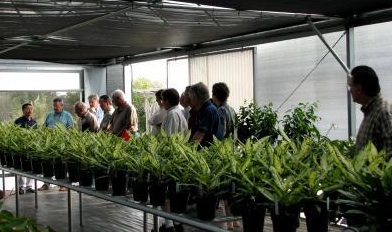
Features
Applications
Beef
Composted dairy manure in plant production
November 17, 2009 by Marg Land
 November 12, 2009 –
November 12, 2009 –
Researchers are testing composted dairy manure as an economical and
environmentally sound alternative to peat.
November 12, 2009 — Peat
has been a major component of substrates used in container plant production
since the 1960s. Highly porous with the capacity to hold water, peat makes an
ideal rooting and growing medium for potted plants. But harvesting peat (and
draining valuable peatlands in the process) releases the carbon stored in peat
into the atmosphere as carbon dioxide. And because peat plays an important role
in wetland ecosystems — peat bogs improve groundwater quality and are unique
habitats for wild plants and animals — the use of peat has been challenged and
peat mining is increasingly regulated.
Researchers have worked
for years to find alternative organic materials that can be used as partial or
complete substitutes for peat. Composted biosolids, municipal solid waste, and
yard trimmings have all been investigated as possible components for use in
bedding, landscape and foliage plant production. Now, composted dairy manure is
being tested as an economical and environmentally sound alternative to peat.
 |
|
| Researchers show off dumb cane plants grown in cowpeat at the MREC shadehouse. (Credit: Photo by Qiansheng Li) |
Scientists Qiansheng Li,
Jianjun Chen, Russell D. Caldwell, and Min Deng from the Department of
Environmental Horticulture and Mid-Florida Research and Education Center (MREC)
at the University of Florida’s Institute of Food and Agricultural Sciences,
published a research report in HortTechnology that evaluated the potential for
using cowpeat, a composted dairy manure, as a component of container substrates
for foliage plant propagation.
For the study, a
commercial formulation (20 percent perlite and 20 percent vermiculite with 60
percent Canadian or Florida peat, based on volume) was used as control, and
peat was replaced by cowpeat at 10 percent increments up to 60 percent, which
produced 14 substrates. The 14 substrates were used for rooting single-node
cuttings of golden pothos (Epipremnum aureum) and heartleaf philodendron (Philodendron
scandens ssp. oxycardium) and three-node cuttings of Florida Spire fig (Ficus
benjamina) and germinating seeds of sprenger asparagus (Asparagus densiflorus)
in a shaded greenhouse.
The research showed that
container substrates formulated by incorporating 10 to 60 percent cowpeat had
physical and chemical properties similar to the commercial Canadian and Florida
peat-based substrates. Biological testing also demonstrated that all tested
cuttings rooted and seed germination rates of cowpeat substrates were greater
than or comparable to those of control substrates.
The researchers observed
that the promising results of the study suggest that there is a potential for
using cowpeat for foliage plant propagation and probably for foliage plant
production.
“The use of cowpeat will
provide the containerized plant industry with an alternative to peat, which in
turn reduces peat mining and encourages composting of dairy manure, thus
contributing to the well-being of our environment,” Chen concluded.